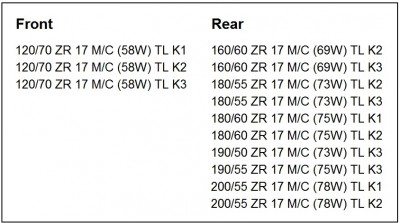EICMA launch for Metzeler’s new racing supersport tyre

Metzeler has unveiled the successor to its Racetec Interact. The EICMA motorcycle fair in Italy formed the backdrop for the debut of the new Racetec RR racing supersport tyre, which is available in three separate versions and said to have been developed based on Metzeler’s experience in road racing competition.
According to the manufacturer, the main benefits the Racetec RR offers are grip in all conditions, precision and stability and performance consistency throughout the life of the tyre Unlike its predecessor, all Racetec RR sizes and compounds are W speed rated, allowing them to be used on public roads as well as circuits. The tyre is described as an “evolution” of the Racetec Interact, and its design and testing saw its use in major competitions such as the North West 200, Metzeler Ulster Grand Prix, Southern 100 and especially the Isle of Man TT, where it won the supersport class on the Triumph Daytona ridden by Gary Johnson.
The new tyre, depending on the compound version, is aimed at all levels of racers plus trackday riders. The three available compounds are simply known as K1, K2 and K3.
K1 – A soft compound tyre distinguished by a blue stripe on the tread and a K1 label in blue on the sidewall.
K2 – Medium compound with a green tread stripe and green K2 sidewall label.
K3 – A hard compound tyre with a yellow tread stripe and K3 sidewall label.
While the K3 compound is dedicated to non-competitive use and can be used at any temperature, in any condition or asphalt abrasiveness, and is able to offer a significantly greater mileage, the other two versions come with certain strings attached. For rear tyres, Metzeler says the K1 compound is best suited to hot asphalt while the K2 is better for cold tarmac. Choice of front tyre compound depends not only on outdoor temperature and track layout, but also on riding style. In general, with regards to weather conditions, when the track temperature increases, the compound tends to lose its compactness and rigidity. This behaviour can cause movement problems in the ‘leaning’ stage. A more rigid compound such as K2 can reduce this effect. Conversely, when the track is cold, the compound tends to become more rigid and this penalises grip and stability while braking. In these conditions it is better to use a soft compound such as the K1.
A feature of road racing is the presence of very long straights, where the bikes maintain speeds above 300 km/h for a long time. This situation typically generates a warming of the central section of the tyre that is in contact with the ground and a cooling on the sides. As a result, when entering the curve after a straight, the side’s operating temperature may not be within the correct range to ensure the necessary grip. Therefore the Racetec RR uses a bi-compound rear solution with a ‘cap and base’ structure – the centre compound supports the lateral compound positioning in the substrate of the tread. While generating less heat, this centre compound is able to distribute it in the substrate, heating the compound present on the sides. With this solution, the longer the straight, the more time the central compound will be in contact, consequently warming the side sections and maintaining operating temperature.
The layout of the central longitudinal grooves in the Racetec RR tread pattern is designed to have a compact tread in the central section to optimise straight line stability, while Metzeler says the position of the transverse grooves provides cornering grip in all road conditions while minimising the effects of wear.
The Racetec RR casing design addresses the issue of stability and the vibration that can result when riding on straights at high speed. The casing material used in the tyre increases lateral stiffness to minimise these problems, the manufacturer shares. And the profiles of the crown and sides been designed to absorb roughness and, at the same time, dampen the deformation coming from impacts from uneven road surfaces without generating vibration.
The Racetec RR will be available at all from January 2015 in the following sizes and compounds:




Comments